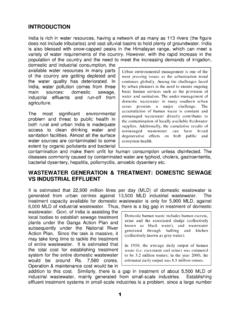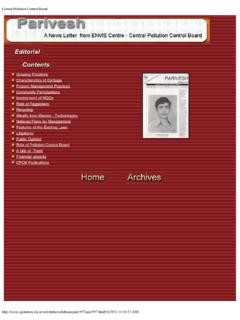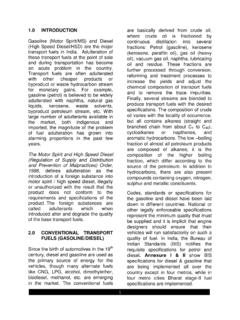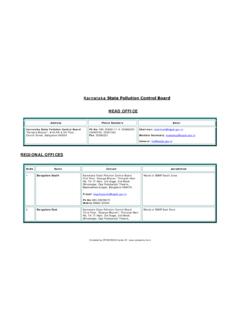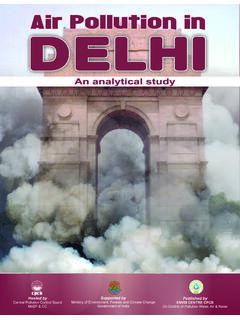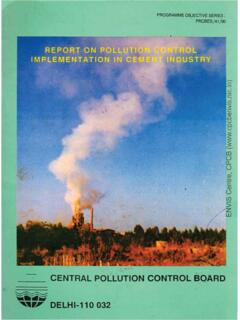Transcription of Central Pollution Control Board - CPCB ENVIS
1 Central Pollution Control [9/6/2012 10:59:19 AM] Coal ReservesCoal Production and DemandCoal Mining PracticesCoal QualityEnvironmental Issues of Coal MiningEnvironmental Issues in Coal Based Power GenerationCoal Cleaning MethodsClean Coal Combustion TechnologiesCoal Bed Methane RecoveryPost Combustion TechnologyIssues and Action Points at a GlanceCentral Pollution Control [9/6/2012 10:59:20 AM] Contents Archives HomeAmong the fossil fuels, coal has acquired the dubious distinction of being the dirtiest an attribute is on account of environmental damage and Pollution problems causedduring mining, processing, end use and wastes of coal. Land subsidence in undergroundmines, ugly scars of land in abandoned open cast mines, emissions of fly ash duringcombustion of coal and huge quantities of ash generated from boilers of coal based powerplants and industrial houses are among the hosts of problems associated with handling anduse of coal.
2 Emission of carbon dioxide, an important component of "green house gases"(GHGs) and global warming, is yet another emerging concern linked with burning of coal. However, inspite of all the odds, coal constitutes a major source for catering to our growingenergy needs. With the proper technologies and initiatives for better management, it ispossible to reduce the hazards otherwise caused. Through scientific mining practicesfollowed by land reclamation, beneficiation for ash reduction at source, improvement incombustion methods, use of efficient electrostatic precipitators/bag filters for trapping of flyash emission and effective management of ash including its utilisation for bricks, cementand such other purposes, many of the problems can be prevented and controlled.
3 With these objectives in view, the Central Pollution Control Board (CPCB) has laid downthe environmental guidelines for coal mining activities, prescribed the use of beneficiatedcoal with lower ash content in power plants and laid down the norms for emissions andeffluents from coal combustion systems. In this Issue of Parivesh, as collated by my colleagues Dr. S. Paliwal, Shri Lalit Kapur andDr. B. Sengupta, an overview of the present status and possibilities for clean coal initiativesare highlighted. Dilip Biswas Chairman,CPCBC entral Pollution Control [9/6/2012 10:59:21 AM]Clean Coal Initiatives COAL RESERVESI ndia with percent of the world reserves, ranks sixth in the world in coal resources, occurring in Gondwana andtertiary formations.
4 The Gondwana coals are largely confined to river valleys such as the Damodar (West Bengal andBihar), Mahanadi (Orissa), and Godavari (Maharashtra and Andhra Pradesh). Coal fields of Assam of Jaintia andBarail series belong to the Tertiary age. The lignite deposits of Jammu and Kashmir, Kerala, Tamil Nadu andGujarat are also of the Tertiary age. The geographical distribution of coal reserves is shown in Fig. 1. Central Pollution Control [9/6/2012 10:59:21 AM] Most of the coal reserves in India are concentrated in the peninsular part within 78 to 88 degrees East longitude and22 to 24 degrees North latitude. As per Geological Survey of India, the estimated coal reserves, down to a depth of1,200 metre, stood at million tonnes as on Of these estimated reserves, down to a depth of 1,200metres, which is considered economically viable are 90 percent of the total reserves.
5 About 83 percent of totalresources are non-coking coals and 14 percent belongs to coking coals (Table 1).Table 1 : Gradewise Reserves of Non-Coking Coal (billion tonnes) of major CoalfieldsSuperior Grade(A+B+C)(5800 Kcal/Kg)IntermediateGrade (D)(5000 Kcal/Kg)Inferior Grade(E+F+G)(4000 Kcal/Kg) & Pollution Control [9/6/2012 10:59:21 AM] Minor (billion tonnes) (%)(16)(13)(710)Besides being a major source of energy generation, coal is also utilised as feedstock for a variety of products asshown in the schematic diagram on coal utilisation (Fig. 2).Back to ContentCentral Pollution Control [9/6/2012 10:59:22 AM]Clean Coal Initiatives COAL PRODUCTION & DEMANDCoal production in India sharply increased from 30 million tonnes in 1940 to over 290 million tonnes in , India ranks 3rd amongst the coal producing countries in the World.
6 Future demand of coal for major industrialuses is given in Table 2 : Coal Demand Forecast (Million tonnes)SectorEstimated Coal Demand 1996-97* * Actual Coal 70 percent of total production is used by the power generation sector while steel and cement are also amongthe major consumers (Table 3).Table 3 : Consumption of coal in power sectorYearCoal consumption (million tonnes)Electricity installed capacity(MW) , to ContentCentral Pollution Control [9/6/2012 10:59:22 AM] Central Pollution Control [9/6/2012 10:59:22 AM]Clean Coal Initiatives COAL MINING PRACTICESI ndia's total land area is million sq. km and within this only area (about 16,000 sq. km) is coal of this coal bearing area, active coal mining area is about 2500 sq. km. Maximum land degradation in coalmining is caused by open-cast mining and it is currently confined to 20% of the coal bearing land.
7 Additional areasthat could be used for open-cast mining would be around 5 to 10% of the coal bearing land. Thus, the area whereland degradation has taken place and is likely to take place is around of the land production of coal peaked in the late seventies and has fallen slowly since then. Surface mining, on theother hand, has soared from16 to 160 million tonnes per annum. Of the 588 mines in India, 355 are under-ground,but opencast accounts for 75 percent of production and employs only 16 percent of the total mining work is higher in the opencast sector. However, the pace of growth cannot be sustained for long, as strippingratios will increase and mining operations run into land access and other environmental problems.
8 Undergroundmining is largely a ' Board and pillar' operation. Longwall was introduced in 1978 and by 1993, 20 longwall unitswere to ContentCentral Pollution Control [9/6/2012 10:59:23 AM]Clean Coal Initiatives COAL QUALITYThe quality of Indian coal is mainly attributed to its origin. Due to drift origin of Indian coal, inorganic impurities areintimately mixed in the coal matrix, resulting in difficult beneficiation characteristics. Over 200 million tonnes ofcoal reach the consumers with ash content averaging 40 percent. Based on ash content, gross calorific value anduseful heat value, Indian coal is classified in six categories as given in Table 4 : Grading and Quality of coalGrade(Ash + Moisture % ) heat value(UHV)( ) or lessAbove content in Indian coal is generally less than percent and the Chlorine content is less than in coal ranges from to ppm in Indian coals against upto 20 ppm in Russian coals, to ppm inBelgium coals, to ppm in Canadian coals and to ppm in American coals.
9 ( Source : (1997) "Clean coal technolgy Indian context"; Indo-European Seminar on Clean coal technology, New Delhi)Back to ContentCentral Pollution Control [9/6/2012 10:59:25 AM]Clean Coal Initiatives CLEAN COAL COMBUSTION TECHNOLOGIESS team turbines can run on a variety of fuels but coal continues to remain a popular choice. However, the traditionalcoal-fired plants suffer from two major drawback: overall efficiency levels are low and Pollution levels are environmental concerns and the need to improve conversion efficiency levels have led to the developmentof clean coal technologies. The most popular of these technologies are Fluidised Bed Combustion (FBC), PressurisedFluidised Bed Combustion Combined Cycle (PFBC) and Integrated Gasification Combined Cycle (IGCC).
10 Improvement in overall performance of steam turbines for thermal power plants can be brought about largely throughtwo kinds of advancement. Firstly,through improvement in mechanical efficiency by reducing aerodynamic andleakage losses as the steam expands through the turbine. Secondly, through improvement in thermodynamicefficiency by increasing the temperature and pressure at which heat is added to the power TechnologyThe steam temperature can be raised to levels as high as 580 to 600 C and pressure over 300 bar. Under theseconditions, water enters a phase called "supercritical" with properties in between those of liquid and gas. Thissupercritical water can dissolve a variety of organic compounds and gases, and when hydrogen per-oxide and liquidoxygen are added, combustion is triggered.


